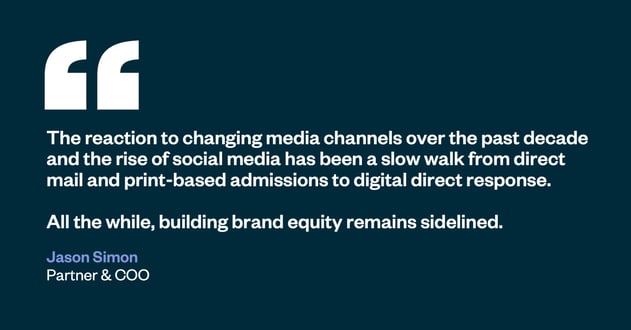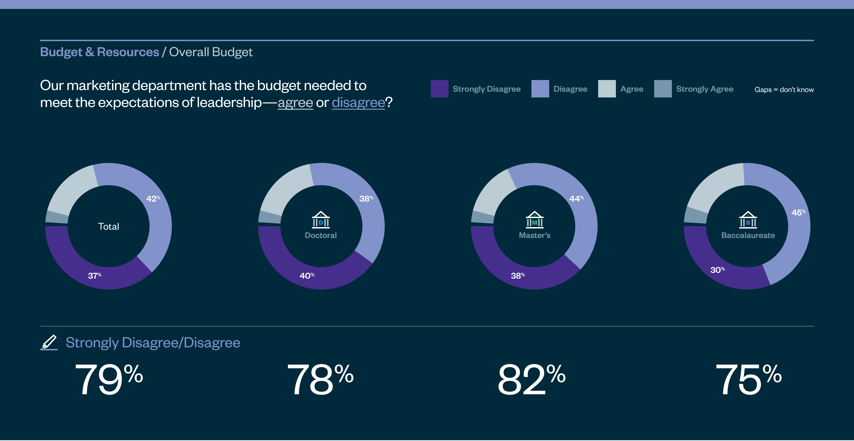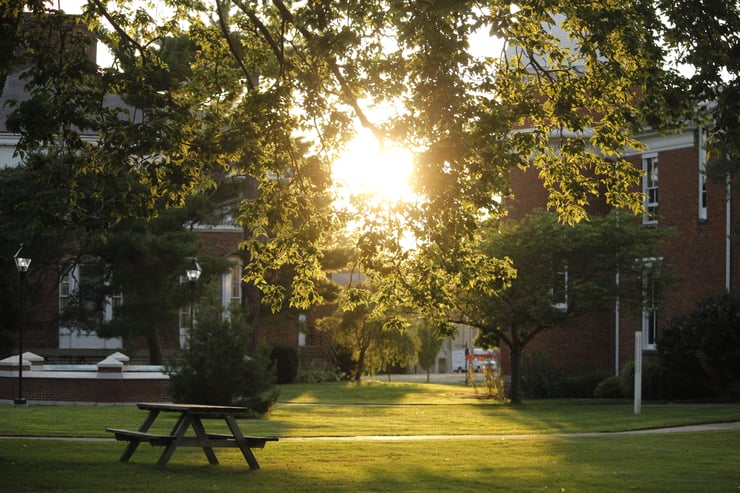Just before the holidays, I got an email from a client and close friend who is the VP of Marketing at a small, private college. He wrote:
“Just launched this big digital campaign for our one of our graduate programs. Nice strategy, good landing page, fine digital targeting, and it’s generated three form submissions in two months!
We'll see how it performs over time, but the data and results I’m seeing from digital are falling way short in comparison to the results I'm seeing with our TV, video, and brand awareness work over the past two years.”
And he shared this great post from AdContrarian.
Around the same time, we were making sense of and posing some questions from the data and analysis of our biennial survey of higher ed marketing leaders. Then, the controversy over the Peloton woman ad and the fantastic follow-up from Aviation Gin hit in a matter of days.
With some time to reflect over the holidays—and following a few rides on my Peloton and some martinis (jeez, talk about knowing your target market)—I began to think about how these things are related, and what higher ed marketers might consider in putting the pieces together.
As the AdContrarian article notes:
“In all the jabbering about marketing, and all the strategic gymnastics that marketers put themselves through, the simplest and most obvious objective of marketing should be to create fame. Brands that are famous have an enormous advantage over brands that aren't famous.
The most expensive way to become famous is through advertising. It is the most expensive, but also the most reliable. It is the only avenue to fame that you can buy your way into.”
Higher ed has its premium/luxury brands: Ivies, top-rated AAU’s, flagships, elite or recognized privates, and those others that are fighting for increased market share or, worse, to stay in business. This status may be well-earned over hundreds of years, gained through the visibility of big-time athletics, or maximized from the assumed status that comes along with rankings.
These “famous” brands just need to reinforce their stories, have some presence, make sure their audiences know something new, or offer a reminder of their connection or impact. The less premium the brand, however, the more they need to be recognized and build awareness, at a minimum. And the rub is that the less “premium” your higher ed brand is, the more important it is that you invest in building and promoting that brand.
Which brings us to the findings of our study on advertising investment. Overall, nearly 80 percent of higher ed marketers feel they lack the budget to be successful. They spend only 18-25 percent of their total marketing budget on advertising. And while 2 in 3 increased their budgets for digital advertising, just 15 percent increased their traditional spends.
Questions abound. Is money being spent appropriately? Is the balance appropriate? Or, most importantly, given that overall spending is so small, is it worth spending any money at all on advertising?
The challenge is most significant for the “non-famous” brands, and the answer, unfortunately, is one that most schools don’t want to admit. Spending limited budgets solely on digital advertising and marketing won't build brand awareness and market penetration that's crucial to establishing long-term brand equity. The reaction to changing media channels over the past decade and the rise of social media has been a slow walk from direct mail and print-based admissions to digital direct response. All the while, building brand equity remains sidelined.

Digital marketing feels more valuable to higher ed because it’s easier to measure.
When you're given a mountain of data to parse via web inquiry forms, click thru rates, and impressions, it can be tempting — if not inevitable — to publish reports that are little more than displays of vanity metrics: pretty to look at, but often poor indicators of actual success. This isn’t necessarily intentional— it’s in our nature to want to see results. And when investing five and six figure sums into campaigns, not measuring progress feels negligent (and it should). But the true goal should be aligning measurement to what actually drives long-term, strategic, and all-encompassing brand equity: what do people think of your institution?
As AdContrarian notes:
“Highly individualized advertising makes advertising a private, rather than public, experience. Online, we all live in our own little personalized, precision-targeted digi-world. This is not an environment that is conducive to growing a brand.”
Digital advertising and SEM is saturated by competition for online programs and big players dominating ad spend (think SNHU, ASU Online, Purdue Global, WGU). But locally, smaller public and private schools are losing out on increasing market presence and visibility by ignoring the public visibility of brand advertising.
It’s also important to consider the level of investment that a college education requires. For many, it will be the second largest investment in their lifetime. How often do you see premium brands or big-ticket purchases relying on digital as their primary source of marketing investment? It’s one thing to buy tickets to an event or a new sweater based on a targeted digital ad, but a $30k/year-plus purchase requires the confidence of brand recognition.
Which brings us back to Peloton and Aviation Gin. Determining whether the “Peloton woman” ad was tone-deaf, offensive, or just a miss is somewhat insignificant. Peloton knows its market. It’s selling a premium product that costs $3,500 when competitors offer slightly less sophisticated products at a fraction of the cost. They have built their brand by investing in marketing channels to give them visibility, which acts as a leverage point in supporting their digital calls-to-action. Their integrated strategy has been very successful as Peloton saw its net revenue more than double last quarter, and even the stock price has fully rebounded from the controversy.
For Aviation Gin, the goal was the same—capitalize on the moment to become famous. Their strategy (boosted by the fame of Ryan Reynolds) was a lot less investment but delivered an incredible social and PR moment.
Marketing in higher ed has gotten smarter and more sophisticated in recent years. But budgets and investment are a constant battle for marketing leaders. With such precious resources, marketers need to make wise decisions on how to spend and prioritize their marketing investments. Overly investing in digital advertising may feel highly targeted and easily measurable, but it's likely to come up short when measuring long-term success.


%20(1).jpg)










